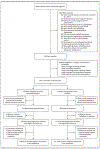Dexmedetomidine or Propofol for Sedation in Mechanically Ventilated Adults with Sepsis
- PMID: 33528922
- PMCID: PMC8162695
- DOI: 10.1056/NEJMoa2024922
Dexmedetomidine or Propofol for Sedation in Mechanically Ventilated Adults with Sepsis
Abstract
Background: Guidelines currently recommend targeting light sedation with dexmedetomidine or propofol for adults receiving mechanical ventilation. Differences exist between these sedatives in arousability, immunity, and inflammation. Whether they affect outcomes differentially in mechanically ventilated adults with sepsis undergoing light sedation is unknown.
Methods: In a multicenter, double-blind trial, we randomly assigned mechanically ventilated adults with sepsis to receive dexmedetomidine (0.2 to 1.5 μg per kilogram of body weight per hour) or propofol (5 to 50 μg per kilogram per minute), with doses adjusted by bedside nurses to achieve target sedation goals set by clinicians according to the Richmond Agitation-Sedation Scale (RASS, on which scores range from -5 [unresponsive] to +4 [combative]). The primary end point was days alive without delirium or coma during the 14-day intervention period. Secondary end points were ventilator-free days at 28 days, death at 90 days, and age-adjusted total score on the Telephone Interview for Cognitive Status questionnaire (TICS-T; scores range from 0 to 100, with a mean of 50±10 and lower scores indicating worse cognition) at 6 months.
Results: Of 432 patients who underwent randomization, 422 were assigned to receive a trial drug and were included in the analyses - 214 patients received dexmedetomidine at a median dose of 0.27 μg per kilogram per hour, and 208 received propofol at a median dose of 10.21 μg per kilogram per minute. The median duration of receipt of the trial drugs was 3.0 days (interquartile range, 2.0 to 6.0), and the median RASS score was -2.0 (interquartile range, -3.0 to -1.0). We found no difference between dexmedetomidine and propofol in the number of days alive without delirium or coma (adjusted median, 10.7 vs. 10.8 days; odds ratio, 0.96; 95% confidence interval [CI], 0.74 to 1.26), ventilator-free days (adjusted median, 23.7 vs. 24.0 days; odds ratio, 0.98; 95% CI, 0.63 to 1.51), death at 90 days (38% vs. 39%; hazard ratio, 1.06; 95% CI, 0.74 to 1.52), or TICS-T score at 6 months (adjusted median score, 40.9 vs. 41.4; odds ratio, 0.94; 95% CI, 0.66 to 1.33). Safety end points were similar in the two groups.
Conclusions: Among mechanically ventilated adults with sepsis who were being treated with recommended light-sedation approaches, outcomes in patients who received dexmedetomidine did not differ from outcomes in those who received propofol. (Funded by the National Institutes of Health; ClinicalTrials.gov number, NCT01739933.).
Copyright © 2021 Massachusetts Medical Society.
Figures


Comment in
-
Evolution of sedation management in the intensive care unit (ICU).Intensive Care Med. 2022 Nov;48(11):1625-1628. doi: 10.1007/s00134-022-06806-x. Epub 2022 Jul 29. Intensive Care Med. 2022. PMID: 35904562 Free PMC article. No abstract available.
References
-
- Fleischmann C, Scherag A, Adhikari NK, et al. Assessment of global incidence and mortality of hospital-treated sepsis: current estimates and limitations. Am J Respir Crit Care Med 2016;193:259–72. - PubMed
-
- Vincent J-L, Marshall JC, Namendys-Silva SA, et al. Assessment of the worldwide burden of critical illness: the Intensive Care Over Nations (ICON) audit. Lancet Respir Med 2014;2:380–6. - PubMed
-
- Ely EW, Shintani A, Truman B, et al. Delirium as a predictor of mortality in mechanically ventilated patients in the intensive care unit. JAMA 2004;291:1753–62. - PubMed
Publication types
MeSH terms
Substances
Associated data
Grants and funding
LinkOut - more resources
Full Text Sources
Other Literature Sources
Medical
